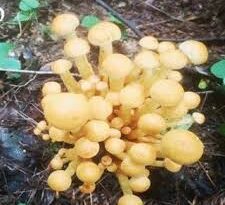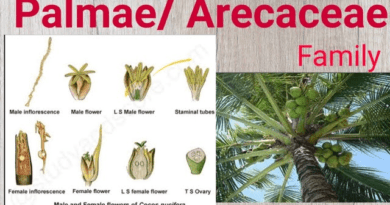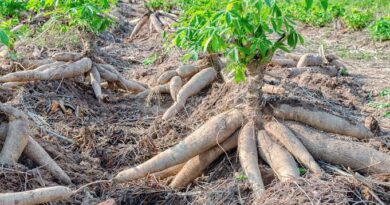The Cowpea Peduncle: Economic Importance, Uses, and By-Products
The cowpea peduncle is a vital part of the reproductive anatomy of cowpea plants (Vigna unguiculata), serving as the main structural support for the inflorescence, or flower cluster. As a legume species, cowpeas produce flowers and pods in clusters along the peduncle, which emerges from the main stem of the plant.
The peduncle is a slender, elongated structure that extends from the main stem of the cowpea plant to support the inflorescence. It may vary in length depending on the specific variety of cowpea and the stage of development of the inflorescence. The peduncle is typically flexible, allowing the inflorescence to sway gently in the wind while maintaining its position.
One of the primary functions of the cowpea peduncle is to position the inflorescence in a way that maximizes exposure to sunlight. By holding the flowers and pods away from the main stem of the plant, the peduncle ensures that they receive adequate sunlight for photosynthesis and reproductive development. This positioning is essential for promoting healthy growth and maturation of the flowers and pods.
In addition to supporting the inflorescence, the cowpea peduncle also plays a role in facilitating pollination and fertilization. By positioning the flowers and pods away from the main stem of the plant, the peduncle helps to ensure that they are easily accessible to pollinators such as bees, butterflies, and other insects. This accessibility is crucial for promoting successful pollination and fertilization, ultimately leading to the production of seeds.
As the flowers on the inflorescence mature and are fertilized, they develop into pods containing seeds. The peduncle continues to provide support for the developing pods, ensuring that they remain attached to the plant until they are fully mature and ready for harvest. This support helps to prevent damage to the pods and ensures that the seeds inside develop properly.
Once the pods have matured and dried, the peduncle may also facilitate the dispersal of seeds. As the pods dry out, they may split open along the seams, releasing the seeds inside. The peduncle helps to position the pods in a way that allows the seeds to be dispersed by wind, animals, or human activities, facilitating the spread of the plant and the establishment of new populations.
In summary, the cowpea peduncle is a crucial structure that supports and positions the inflorescence of cowpea plants, facilitating processes such as pollination, fertilization, and seed development. Its role in promoting healthy growth and reproduction is essential for the continued propagation and cultivation of cowpea crops for food and agricultural purposes.
The Economic Importance and Uses of Cowpea Peduncle

1. Fruit Support: The primary function of cowpea peduncles is to support and hold the developing cowpea pods (fruits) in place. This ensures proper positioning of the pods for optimal exposure to sunlight and airflow, promoting fruit development and seed maturation.
2. Crop Yield: Healthy cowpea peduncles contribute to higher crop yields by ensuring the proper development and maturation of cowpea pods. Intact peduncles prevent premature pod drop and seed loss, maximizing seed set and overall crop productivity.
3. Marketability: Cowpea peduncles enhance the marketability and commercial value of harvested cowpea pods. Pods with attached peduncles are perceived as fresher and more visually appealing, attracting consumers and commanding higher prices in agricultural markets.
4. Culinary Use: While not commonly consumed directly, cowpea peduncles are edible and can be cooked along with the tender pods in various culinary dishes. In some cuisines, cowpea pods with attached peduncles are valued for their crunchy texture and nutty flavor.
5. Seed Distribution: After harvest, cowpea peduncles facilitate the distribution and dispersal of cowpea seeds. The attachment of mature pods to the plant via peduncles allows seeds to remain in place until they are ready for harvest, preventing premature seed loss and ensuring efficient seed collection.
6. Livestock Forage: Cowpea peduncles, along with other plant parts, may be used as fodder for livestock such as cattle, sheep, and goats. Harvested cowpea residues provide supplemental nutrition to grazing animals, supporting their growth, reproduction, and overall health.
7. Organic Mulch: After harvest, cowpea peduncles can be incorporated into the soil as organic mulch or green manure. Mulching with cowpea residues helps conserve soil moisture, suppress weed growth, and improve soil fertility, promoting sustainable agricultural practices and crop production.
8. Soil Improvement: Decomposing cowpea peduncles contribute organic matter to the soil, enhancing soil structure, nutrient cycling, and microbial activity. Their incorporation into the soil improves soil health and fertility, supporting healthy plant growth and crop yield in agricultural systems.
9. Companion Planting: Cowpea peduncles, along with the entire plant, can be utilized in companion planting schemes to enhance soil fertility and pest management. Intercropping cowpeas with other crops benefits soil health and biodiversity while reducing the need for synthetic inputs.
10. Cover Cropping: In cover cropping systems, cowpea peduncles and residues provide ground cover and organic matter to protect and improve soil quality during fallow periods. Cover crops such as cowpeas contribute to erosion control, weed suppression, and soil conservation in agricultural landscapes.
11. Nutrient Cycling: Cowpea peduncles play a role in nutrient cycling within agroecosystems by returning organic matter and nutrients to the soil upon decomposition. Their incorporation into the soil helps replenish soil nutrients, supporting sustainable nutrient management practices in agriculture.
12. Soil Erosion Control: By improving soil structure and stability, cowpea peduncles contribute to soil erosion control in agricultural fields and landscapes. Their incorporation into the soil helps prevent erosion, nutrient runoff, and soil degradation, protecting valuable land resources.
13. Water Infiltration: Cowpea peduncles and residues enhance water infiltration and retention in the soil, improving soil moisture levels and drought resilience in agricultural systems. Their presence improves soil structure and porosity, allowing water to penetrate deeper into the soil profile.
14. Organic Weed Control: Cowpea peduncles, when used as mulch or green manure, suppress weed growth by shading the soil surface and inhibiting weed seed germination. This natural weed control method reduces the need for synthetic herbicides, promoting organic farming practices and environmental sustainability.
15. Soil Carbon Sequestration: Decomposing cowpea peduncles contribute to soil carbon sequestration, storing carbon in the soil as organic matter. This process helps mitigate climate change by removing carbon dioxide from the atmosphere and storing it in stable soil organic pools.
16. Biodiversity Conservation: By promoting soil health and ecosystem resilience, cowpea peduncles contribute to biodiversity conservation in agricultural landscapes. Healthy soils support diverse microbial communities, beneficial insects, and plant species, enhancing ecosystem services and ecological balance.
17. Agroforestry Integration: Cowpea peduncles and residues can be integrated into agroforestry systems to enhance soil fertility, biodiversity, and crop productivity. In agroforestry settings, cowpeas serve as companion plants or understory crops, providing multiple benefits to tree crops and the surrounding environment.
Read Also: Honey Production Guide: The Basics to Get Started
The Products and By-products That Can Be Derived From Cowpea Peduncle

1. Organic Fertilizer: Cowpea peduncles, along with other plant residues, can be composted to produce nutrient-rich organic fertilizer for
soil enrichment. Compost made from cowpea residues improves soil fertility, structure, and microbial activity, promoting healthy plant growth and crop yield.
2. Livestock Feed: Cowpea peduncles and other plant parts may be utilized as fodder for livestock such as cattle, sheep, and poultry. Dried or ensiled cowpea residues provide supplemental nutrition to grazing animals, supporting their growth, reproduction, and overall health.
3. Soil Amendment: Decomposing cowpea peduncles contribute organic matter to the soil, enhancing soil structure, nutrient availability, and water retention. Their incorporation into the soil improves soil health and fertility, supporting sustainable agriculture and crop production.
4. Vermicompost Substrate: Cowpea peduncles can be used as a substrate for vermicomposting, where earthworms decompose organic matter to produce nutrient-rich worm castings. Vermicompost enhances soil fertility and microbial activity, benefiting plant growth and crop yield in organic farming systems.
5. Green Manure: Cowpea peduncles and residues can be incorporated into the soil as green manure to improve soil fertility and structure. Green manuring with cowpea residues enhances soil organic matter content, nitrogen fixation, and microbial diversity, promoting sustainable crop production.
6. Soil Conservation: By improving soil structure and stability, cowpea peduncles contribute to soil conservation efforts in agricultural fields and landscapes. Their incorporation into the soil helps prevent erosion, nutrient runoff, and soil degradation, protecting valuable land resources.
7. Organic Mulch: Cowpea peduncles can be used as organic mulch to cover the soil surface and suppress weed growth. Mulching with cowpea residues conserves soil moisture, moderates soil temperature, and enhances nutrient cycling, supporting healthy plant growth and crop yield.
8. Plant Nutrition: Decomposing cowpea peduncles release nutrients such as nitrogen, phosphorus, and potassium into the soil, providing essential nutrition for plant growth. Their incorporation into the soil improves soil fertility and nutrient availability, supporting vigorous plant growth and high crop yields.
9. Soil Microbial Activity: Cowpea peduncles promote soil microbial activity by providing organic matter and habitat for beneficial soil organisms. Microbes such as bacteria, fungi, and earthworms decompose peduncle residues, releasing nutrients and enzymes that enhance soil health and plant productivity.
10. Sustainable Agriculture: By enhancing soil fertility, biodiversity, and ecosystem resilience, cowpea peduncles support sustainable agriculture practices that conserve natural resources and protect the environment. Their integration into agroecosystems promotes soil conservation, water management, and climate resilience in farming systems.
Read Also: Facts About Honey Bees
Frequently Asked Questions (FAQs) About Cowpea Peduncles

1. What are cowpea peduncles?
Cowpea peduncles are the stalks that attach the cowpea pods (fruits) to the main stem or branches of the cowpea plant. They provide structural support to the developing pods and facilitate seed distribution.
2. How do cowpea peduncles contribute to crop yield?
Cowpea peduncles support the growth and development of cowpea pods, ensuring proper seed maturation and maximum seed set. Intact peduncles prevent premature pod drop, optimizing crop yield and quality.
3. Are cowpea peduncles edible?
While not commonly consumed directly, cowpea peduncles are edible and can be cooked along with the tender pods in culinary dishes. They add texture and flavor to dishes and are valued for their nutritional content.
4. Can cowpea peduncles be used for livestock feed?
Yes, cowpea peduncles, along with other plant parts, can be used as fodder for livestock such as cattle, sheep, and goats. They provide supplemental nutrition and support animal health and growth.
5. How do cowpea peduncles benefit soil health?
Cowpea peduncles contribute organic matter to the soil upon decomposition, enhancing soil fertility, structure, and microbial activity. They improve soil health and support sustainable agriculture practices.
6. Are cowpea peduncles used in soil conservation?
Yes, cowpea peduncles help prevent soil erosion and degradation by improving soil structure and stability. Their incorporation into the soil promotes soil conservation and protects valuable land resources.
7. Can cowpea peduncles be composted?
Yes, cowpea peduncles can be composted along with other organic matter to produce nutrient-rich compost for soil enrichment. Composting cowpea residues is a sustainable practice that improves soil fertility and health.
8. Do cowpea peduncles attract pests or diseases?
Cowpea peduncles are generally not prone to pest infestations or diseases. However, proper crop management practices should be implemented to minimize potential risks and ensure crop health.
9. How do cowpea peduncles contribute to biodiversity conservation?
Cowpea peduncles promote soil biodiversity and ecosystem resilience by supporting diverse microbial communities and beneficial soil organisms. They enhance soil health and contribute to biodiversity conservation in agricultural landscapes.
10. Are there any research studies focused on cowpea peduncles?
Research studies on cowpea peduncles may investigate their role in crop physiology, soil ecology, and agricultural sustainability. Scientists study peduncle anatomy, function, and ecological interactions to improve crop management practices and enhance agricultural productivity.
Read Also: Financial Projections for Waste Management Business









